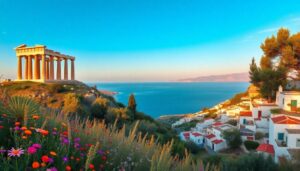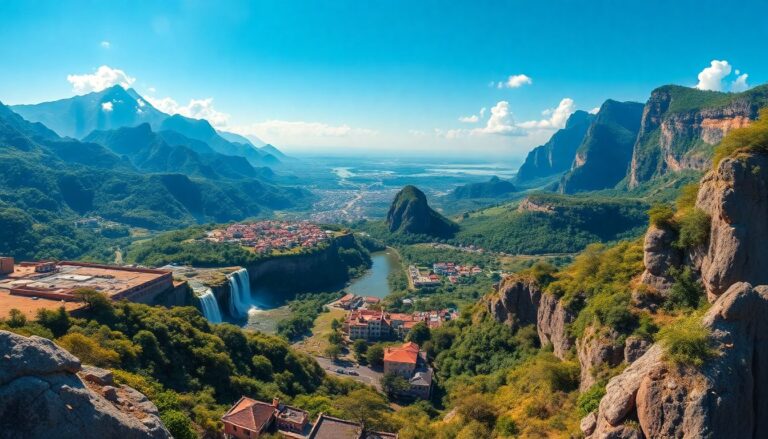
Introduction
Greece stands out as one of the most exciting travel destinations in the world. With its rich past, vibrant culture, and stunning landscapes, it calls to travelers from every corner. Whether you love exploring ancient ruins or relaxing on scenic beaches, Greece has something for everyone. Each visit uncovers new stories, breathtaking views, and unforgettable experiences. This guide will help you discover Greece’s most famous sites and the hidden gems beyond.
Exploring Greece’s Ancient Monuments
The Acropolis of Athens
The Acropolis in Athens is a must-visit symbol of Greece. It boasts iconic structures like the Parthenon, Erechtheion, and the grand Propylaea. These monuments tell stories of ancient Greece’s greatness and its role in shaping Western civilization. When you plan your visit, early mornings or late afternoons are best to avoid crowds. A guided tour can bring history alive with detailed insights and stories about these marvels.
The Palace of Knossos and Minoan Heritage
In Crete lies the Palace of Knossos, the largest Minoan archaeological site. This sprawling ruin reveals the history of a civilization that flourished thousands of years ago. The myths of King Minos and the Minotaur are rooted in this ancient place. Restoration work continues to preserve these structures, but visitors should follow guidelines to help protect the site. Exploring Knossos offers a glimpse into an early advanced society that influenced ancient Greece.
Delphi: The Heart of Ancient Greece
Delphi once held the fame of an oracle believed to predict the future. Today, it’s a top archaeological site surrounded by stunning mountain scenery. Key attractions include the Temple of Apollo, the ancient theater, and the Delphi Archaeological Museum. Guided tours enhance the experience, helping visitors understand its spiritual importance. Visiting in spring or fall means cooler weather and fewer crowds.
Meteora Monasteries
Meteora is famous for its monasteries perched atop tall rock pillars. Built in the 14th century, these spiritual sites dominate the landscape. Today, they’re still active monasteries welcoming visitors. Access involves walking or driving, but the views make every step worthwhile. Photography is popular here, but respectful behavior and proper dress are essential as it remains a place of worship.
Natural Scenery and Iconic Landscapes
The Greek Islands: Santorini, Mykonos, and Crete
Imagine colorful houses with blue domes set against a volcanic caldera—this is Santorini. Mykonos is known for lively nightlife and sandy beaches, while Crete offers a mix of mountains and ancient ruins. These islands stand out because of their volcanic landscapes, charming villages, and crystal-clear waters. Best times to visit are spring and early autumn to enjoy good weather and avoid heavy crowds. Activities include wine tasting, water sports, and exploring caves.
The Peloponnese Region
This region combines natural beauty with history. Nafplio has a lovely coastline perfect for relaxing. Voidokilia Beach offers white sands and turquoise waters. The Taygetus Mountains invite hikers and outdoor lovers. For a scenic drive, follow coastal routes or explore mountain roads. Nearby sites like Olympia and Epidaurus reveal Greece’s ancient past, making this area perfect for combining nature and history.
Mount Olympus and National Parks
As Greece’s highest mountain, Mount Olympus holds mythological roots, once said to be home to gods. Today, it’s a protected park with rich plant and animal life. Hikers and nature lovers can explore its trails, spotting wildlife and enjoying panoramic views. Guided trekking tours are popular, helping visitors stay safe while soaking up nature’s beauty.
Vikos Gorge and Aoös Valley
Vikos Gorge, known as the deepest gorge in the world, offers dramatic cliff views and lush forests. Here, adventure seekers can try rafting, hiking, and birdwatching. It’s best to visit in spring or fall when the weather is mild. Local guides can lead you through the best trails and activities, making sure you get the most from your trip.
Experiencing Greece’s Cultural Festivals and Gastronomy
Traditional Festivals and Celebrations
Greece’s festivals bring locals and visitors together in joyful celebration. The Athens Carnival lights up the city before Lent with costumes and parades. Ochi Day on October 28th remembers Greece’s resistance in WWII with parades and events. Village festivals often feature music, dance, and local rituals. Check the dates before visiting and join in respectfully to experience authentic Greek culture.
Greek Cuisine and Local Markets
Food is at the heart of Greek culture. Moussaka, souvlaki, and fresh seafood options showcase local flavors. Markets like the Athens Central Market or Chania Market burst with colorful produce, cheeses, and handmade goods. Sampling street food and visiting markets gives you a taste of everyday life. Don’t forget to try baklava and local wines—these are Greek treats you won’t want to miss.
Practical Travel Tips and Insights
The best times to visit Greece are late spring (April to June) and early autumn (September to October). These months offer better weather and fewer tourists. Transportation options include ferries connecting islands, rental cars for exploring mainland regions, and public buses in cities. Accommodation choices range from luxury hotels to cozy hostels and eco-lodges. Respect local heritage by following rules at monuments and natural parks, helping preserve Greece’s beauty.
Conclusion
Greece offers an unmatched mix of ancient history and stunning scenery. From grand monuments to peaceful beaches, every corner tells a story. Planning your trip around its famous sites and scenic routes ensures a memorable experience. Whether you’re walking through ruins or relaxing on a sunlit beach, Greece’s magic is impossible to resist. Start planning your journey today and uncover the diverse wonders this incredible country holds.






